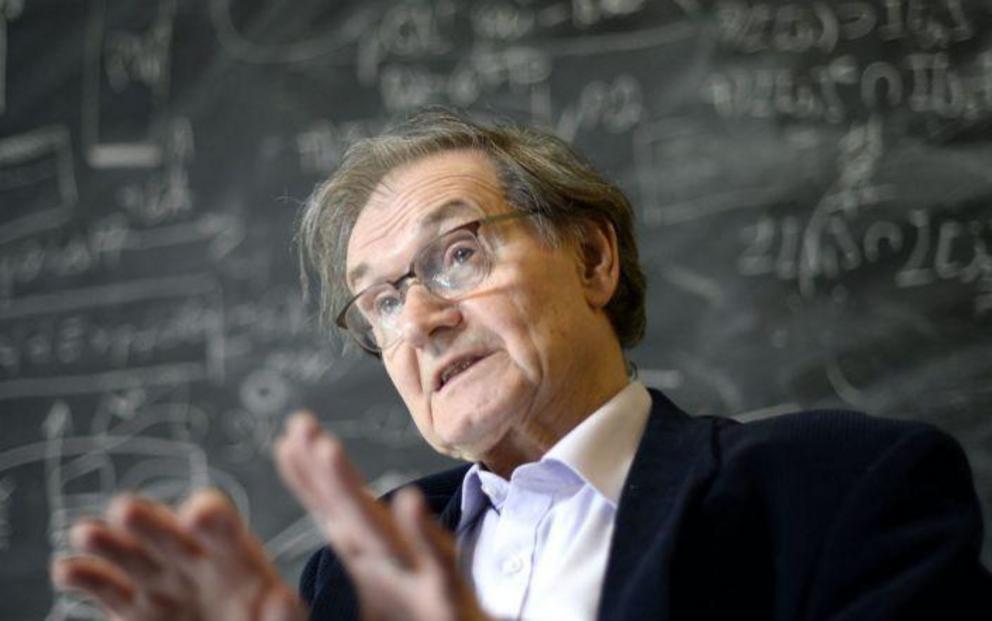An earlier universe existed before the Big Bang
- and can still be observed today, says Nobel winner
An earlier universe existed before the Big Bang and can still be observed today, Sir Roger Penrose has said, as he received the Nobel Prize for Physics.
Sir Roger, 89, who won the honour for his seminal work proving that black holes exist, said he had found six ‘warm’ points in the sky (dubbed ‘Hawking Points’) which are around eight times the diameter of the Moon.

Sir Roger Penrose during interview with Austria Presse Agentur at Institute of Science and Technology, Klosterneuburg, Austria. Sir Roger Penrose Interview at Institute of Science and Technology, Viena, Austria - 21 May 2015 Sir Roger Penrose OM FRS is an English mathematical physicist, mathematician and philosopher of science. He is the Emeritus Rouse Ball Professor of Mathematics at the Mathematical Institute of the University of Oxford - APA Picturedesk Gmbh/Shutterstock/APA Picturedesk Gmbh/Shutterstock
They are named after Prof Stephen Hawking, who theorised that black holes ‘leak’ radiation and eventually evaporate away entirely.
The timescale for the complete evaporation of a black hole is huge, possibly longer than the age of our current universe, making them impossible to detect.
However, Sir Roger believes that ‘dead’ black holes from earlier universes or ‘aeons’ are observable now. If true, it would prove Hawking’s theories were correct.
Sir Roger shared the World Prize in physics with Prof Hawking in 1988 for their work on black holes.
Speaking from his home in Oxford, Sir Roger said: “I claim that there is observation of Hawking radiation.
“The Big Bang was not the beginning. There was something before the Big Bang and that something is what we will have in our future.
“We have a universe that expands and expands, and all mass decays away, and in this crazy theory of mine, that remote future becomes the Big Bang of another aeon.
“So our Big Bang began with something which was the remote future of a previous aeon and there would have been similar black holes evaporating away, via Hawking evaporation, and they would produce these points in the sky, that I call Hawking Points.
“We are seeing them. These points are about eight times the diameter of the Moon and are slightly warmed up regions. There is pretty good evidence for at least six of these points.”
Sir Roger has recently published his theory of ‘Hawking Points’ in Monthly Notices of the Royal Astronomical Society.

Roger Penrose (born 1931), British mathematician, with the Penrose tiling system named after him. Penrose, renowned for his work in mathematical physics, studied this tiling system in the 1970s. Using only two tiles of a particular shape, complex, non-repeating patterns can be generated. Penrose has also worked on black holes, cosmology, quantum mechanics and human consciousness. His awards include the Eddington Medal, the Royal Medal, the Wolf Prize, and the Albert Einstein Medal. Penrose was knighted in 1994. Photographed in 1989 - CORBIN O'GRADY/SCIENCE PHOTO LIBRARY
The idea is controversial, although many scientists do believe that the universe operates in a perpetual cycle in which it expands, before contracting back in a ‘Big Crunch’ followed by a new Big Bang.
Sir Roger said that black holes had also once been controversial. They were first theorised by English country parson John Mitchell in 1783, who speculated that if an object became so dense, its massive gravitational pull would stop even light escaping.
But even Albert Einstein dismissed them as mathematical curiosity, rather than a physical reality.
It was not until 1964, nine years after Einstein’s death, that Sir Roger proposed that black holes are an inevitable consequence of general relativity.
Sir Roger proved that when objects become too dense they suffer gravitational collapse to a point of infinite mass where all known laws of nature cease, called the singularity.
His groundbreaking article is still regarded as the most important contribution to the theory of relativity since Einstein, and increased evidence for the Big Bang.
Sir Roger was in his mid-thirties when he first stumbled upon the idea when walking to a tube station in London on his way to Birkbeck College. Now, 56 years later, he has finally been recognised for his work by the Royal Swedish Academy of Sciences.
“I think it’s a bad thing to get a Nobel prize too early. I know scientists who got their prize too early and it spoiled their science.
“If you’re going to get a Nobel prize for science it’s good to get in when you’re good and old, before you’re absolutely clapped out, when there is still something to do, that’s my advice.
“This dates back to 1964, but the significance of black holes took a long long time to realise, so it’s not surprising, and I think I’m just about old enough now.”
Sir Roger was awarded the honour alongside Professors Reinhard Gerzel, of the Max Planck Institute for Extraterrestrial Physics, and Andrea Ghez of the University of California, who proved there is a supermassive black hole at the centre of the Milky Way, by studying its impact on the stars around it.
Commenting on the prize, Prof Martin Rees, Astronomer Royal and Fellow of Trinity College, University of Cambridge, said it was sad that Prof Hawking had not been alive to share the prize.
“Penrose is amazingly original and inventive, and has contributed creative insights for more than 60 years.
“There would, I think, be a consensus that Penrose and Hawking are the two individuals who have done more than anyone else since Einstein to deepen our knowledge of gravity.
“Sadly, this award was too much delayed to allow Hawking to share the credit with Penrose."
Prof Hawking answered some of the biggest questions facing mankind back in 2018, below:
Announcing the prize, Prof Göran Hansson, secretary general of the Royal Swedish Academy of Sciences, said this year’s award was about ‘the darkest secrets in the universe.’
Prof Toby Wiseman, Professor of Theoretical Physics at Imperial College London, said: “Penrose showed that if you believe Einstein, then black holes form under very general conditions, such as when certain stars die. They must be a physical reality.”
